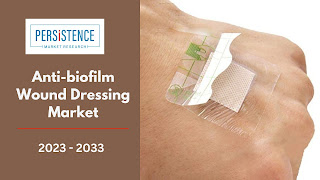- Get link
- X
- Other Apps
- Get link
- X
- Other Apps
Wound care has undergone significant advancements over the years, with innovations constantly aiming to improve healing outcomes and reduce complications. Among the challenges faced in wound management, biofilm formation presents a formidable obstacle, leading to chronic wounds and increased risk of infection. However, the emergence of anti-biofilm wound dressings marks a promising avenue in the fight against microbial colonization. In this article, we delve into the burgeoning market of anti-biofilm wound dressings, exploring novel strategies and technologies driving its expansion.
Anti-biofilm wound dressings are specialized medical devices designed to prevent and manage biofilm formation in chronic wounds. Biofilms, a complex aggregation of microorganisms, complicate wound healing by creating barriers to treatment and harboring pathogens. According to Persistence Market Research's projections, the global anti-biofilm wound dressing market is expected to grow at a CAGR of 11.2%, rising from a valuation of US$ 807 Million in 2023 to an estimated US$ 2.3 Billion by 2033. This growth is driven by a combination of increasing chronic wound cases, advancements in wound care technology, and a growing awareness of the complications associated with biofilms.
Biofilms are structured communities of microorganisms embedded within a self-produced matrix of extracellular polymeric substances (EPS). In the context of wound healing, biofilm formation impedes the natural regenerative process, prolonging inflammation and delaying tissue repair. Moreover, biofilms confer resistance to antimicrobial agents, rendering conventional treatments ineffective and contributing to persistent infections. Consequently, combating biofilm-associated wound infections has become a focal point in wound care research and development.
The Rise of Anti-biofilm Wound Dressings:
Traditional wound dressings primarily serve as barriers to protect the wound bed and absorb exudate. However, the advent of anti-biofilm wound dressings represents a paradigm shift in wound management, incorporating strategies to disrupt biofilm formation and enhance antimicrobial efficacy. These advanced dressings leverage a combination of materials and technologies to address the multifaceted challenges posed by biofilms.
Read More: https://www.persistencemarketresearch.com/market-research/anti-biofilm-wound-dressing-market.asp
Key Strategies Driving Market Expansion:
Bioactive Agents: Anti-biofilm dressings often incorporate bioactive agents known for their antimicrobial properties. These agents, such as silver nanoparticles, iodine, and honey derivatives, exhibit broad-spectrum activity against bacteria and fungi while minimizing cytotoxicity to host tissues. By releasing antimicrobial compounds directly into the wound environment, these dressings effectively inhibit biofilm formation and promote healing.
Modulation of Microenvironment: Altering the wound microenvironment is crucial for disrupting biofilm development. Some dressings employ advanced materials capable of regulating moisture levels, pH, and oxygenation to create an inhospitable environment for microbial growth. Additionally, the incorporation of enzymes or chelating agents helps degrade the EPS matrix, destabilizing biofilm structure and facilitating antimicrobial penetration.
Nanotechnology: Nanotechnology has revolutionized wound dressing design, offering precise control over material properties and enhanced therapeutic effects. Nanostructured materials, such as nanofibers and nanoparticles, possess large surface areas and unique physicochemical properties ideal for delivering bioactive agents and promoting tissue regeneration. Furthermore, nanocarriers enable sustained release of antimicrobial compounds, prolonging their efficacy within the wound site.
Smart Dressings: The integration of smart technologies into wound dressings enables real-time monitoring of wound status and delivery of therapeutic interventions. Smart dressings equipped with sensors can detect early signs of infection or biofilm formation, triggering targeted treatment modalities. Moreover, controlled release systems responsive to environmental cues ensure optimal drug delivery, minimizing adverse effects and maximizing therapeutic outcomes.
Market Outlook and Future Prospects:
The anti-biofilm wound dressing market is poised for substantial growth in the coming years, driven by increasing prevalence of chronic wounds, rising awareness regarding biofilm-related complications, and continuous innovation in wound care technologies. Market players are investing in research and development endeavors to enhance product efficacy, scalability, and affordability, catering to the evolving needs of healthcare providers and patients alike.
Moreover, strategic collaborations between industry stakeholders, academic institutions, and regulatory bodies facilitate knowledge exchange and accelerate the translation of scientific discoveries into clinical applications. By harnessing interdisciplinary expertise and leveraging emerging technologies, the anti-biofilm wound dressing market is positioned to address unmet clinical needs and improve patient outcomes across diverse healthcare settings.
The advent of anti-biofilm wound dressings heralds a new era in wound care, offering targeted solutions to combat microbial colonization and facilitate wound healing. Through innovative strategies and technological advancements, these dressings empower healthcare providers with effective tools to address the complexities of biofilm-associated infections. As the market continues to expand, fueled by ongoing research and collaborative efforts, the promise of enhanced patient care and improved clinical outcomes becomes increasingly attainable.
Follow Us: LinkedIn | Medium | Twitter
About Persistence Market Research:
Business intelligence is the foundation of every business model employed by Persistence Market Research. Multi-dimensional sources are being put to work, which include big data, customer experience analytics, and real-time data collection. Thus, working on “micros” by Persistence Market Research helps companies overcome their “macro” business challenges.
Persistence Market Research is always way ahead of its time. In other words, it tables market solutions by stepping into the companies’/clients’ shoes much before they themselves have a sneak pick into the market. The pro-active approach followed by experts at Persistence Market Research helps companies/clients lay their hands on techno-commercial insights beforehand, so that the subsequent course of action could be simplified on their part.
Contact Us:
Persistence Market Research
G04 Golden Mile House,
Clayponds Lane, Brentford, London,
TW8 0GU UK
Email: sales@persistencemarketresearch.com
Web: https://www.persistencemarketresearch.com
Anti-Biofilm
Biofilm Management
Healthcare
Infection Prevention
innovative solutions
Medical Technology
Wound Dressing
- Get link
- X
- Other Apps

Comments
Post a Comment